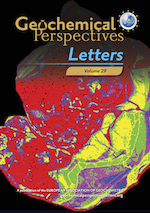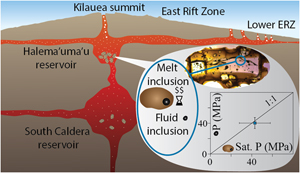 | Reliability of Raman analyses of CO2-rich fluid inclusions as a geobarometer at Kīlauea Abstract: Interpreting signals of volcanic unrest requires knowledge of the architecture of the magmatic system, particularly the depths at which magmas are stored. Such information can be vital to help predict changes in eruptive style and vigour. However, popular petrological tools to assess magma storage depths (e.g., melt inclusions) are costly, present large uncertainties, and are too slow for real time monitoring. Here, we evaluate the reliability of Raman Spectroscopy measurements of CO2-dominated fluid inclusions as a geobarometer relative to microthermometry and melt inclusion barometry. We calculate storage pressures for 102 olivine-hosted fluid inclusions from the 2018 Lower East Rift Zone eruption of Kīlauea, which are statistically indistinguishable to those determined from melt inclusions. We show that calibrated Raman spectroscopy yields densities within 5–10 % of microthermometry for CO2-dominated fluid inclusions (<10 mol % H2O) but is a far more suitable method for systems like Kīlauea dominated by shallow magma storage. Overall, pressures determined from fluid inclusions by Raman spectroscopy are robust and require only a fraction of the time and resources of melt inclusion studies. |
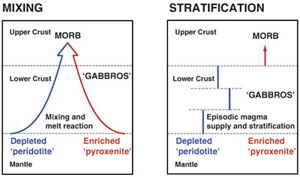 | Mantle depletion recorded by olivine and plagioclase megacrysts in oceanic basalts Abstract: Earth’s oceanic crust is largely formed by melting of the upper mantle where it upwells beneath mid-ocean ridges, providing a geographically widespread elemental and isotopic ‘sample’ of Earth’s interior. Radiogenic isotope variations in oceanic basalts are commonly attributed to compositional heterogeneity in Earth’s upper mantle, albeit reduced by mixing and reaction during melt ascent. Nevertheless, many mid-ocean ridge basalts are biased towards incompatible element enriched radiogenic isotope compositions, and questions remain as to whether their chemistry is indeed representative of the underlying mantle. Here we present Pb isotope data for plagioclase megacrysts (and olivine-megacryst hosted inclusions) from oceanic basalts that crystallised in the lower oceanic crust or mantle, from incompatible element depleted melts. Our data show that the plagioclase megacrysts and olivine grew from melts with substantially less radiogenic Pb compositions than their host lava. High Ca plagioclase megacrysts are common in oceanic basalts, suggesting that depleted melts in the lower crust or mantle may also be widespread, acting to balance the enriched isotope compositions seen in many erupted basalts. |
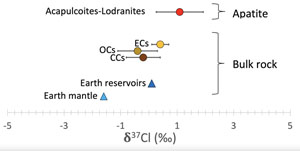 | Chondritic chlorine isotope composition of acapulcoites and lodranites Abstract: Bulk rock chondrites and Earth’s reservoirs share a common chlorine isotopic value, while more differentiated bodies such as the Moon or Vesta record significant chlorine isotopic fractionation in their Ca phosphates. As such, an important but scarcely studied parameter is the effect of melting and differentiation processes on chlorine concentration and isotopic composition of a planetesimal. Here we report chlorine abundances and isotopic compositions for apatite in a range of primitive achondrites, acapulcoites and lodranites. These meteorites originated from a parent body that experienced some partial melting, allowing an assessment of chlorine behaviour during the early stages of planetary evolution in the inner Solar System. Overall, while bulk rock estimates of F and Cl abundances are indicative of degassing during the early stages of partial melting, no chlorine isotopic fractionation is recorded in apatite. Consequently, acapulcoites and lodranites retain their chondritic precursor isotopic signature for chlorine. |
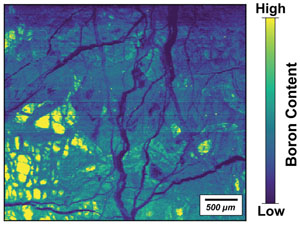 | Imaging of boron in altered mantle rocks illuminates progressive serpentinisation episodes Abstract: Serpentinised mantle rocks reflect the cumulative sum of multiple alteration events, but to date, identifying distinct serpentinisation episodes has remained challenging due to limited knowledge of the spatial distribution of tracers of fluid-rock exchange. Here we present novel high spatial resolution (∼10 μm) boron, nickel, calcium, and lithium concentration maps combined with in situ boron isotope analyses of strongly serpentinised mantle peridotites from the Troodos ophiolite, Cyprus. Our maps indicate strongly heterogenous boron concentrations with high boron concentrations in early formed serpentine replacing olivine but much lower boron contents in mesh-textured serpentine and bastitic pyroxene. Late stage crosscutting serpentine veins have very low boron concentrations. In contrast, boron isotope measurements, made at coarser scales, are remarkably uniform (mean value +11.9 ± 3.2 ‰, 1σ, n = 49). We interpret the high boron serpentine as reflecting the partial preservation of an early pervasive serpentinisation episode by fluids with high boron concentrations sourced from the dehydration of the subducting Cyprus slab. Subsequent serpentine phases with moderate to low boron reflect progressive recrystallisation and leaching by low boron concentration meteoric waters. |
 | Corrigendum to “Titanium isotope constraints on the mafic sources and geodynamic origins of Archean crust” by Hoare et al., 2023 |
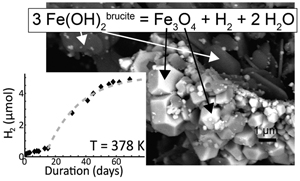 | Kinetics of low-temperature H2 production in ultramafic rocks by ferroan brucite oxidation Abstract: Ferroan brucite, (Mg,Fe)(OH)2, is among the potential mineral candidates for low temperature (<423 K) abiotic H2 production in ultramafic rocks. To verify this assumption, synthetic ferroan brucite with grain size similar to that observed in natural samples (40–100 nm) was reacted with pure water at temperatures ranging from 348 to 573 K. Experimental products are consistent with the reaction 3 Fe(OH)2brucite = Fe3O4 + H2 + 2 H2O. This reaction reached completion in ∼2 months at 378 K and is thermally activated with an activation energy of 145 ± 1 kJ/mol. The standard state formation enthalpy and the third law entropy of amakinite, Fe(OH)2, were refined from the experimental dataset. The new thermodynamic parameters imply that ferroan brucite is stable at significantly lower hydrogen activity than previously calculated. The alteration of Fe-brucite produces H2 at rates compatible with present day observations of H2 emissions in natural settings (ophiolite and mid-oceanic ridges). However, efficient fluid renewal is required, as opposed to H2 production through olivine serpentinisation, which can proceed in static hydraulic conditions. |
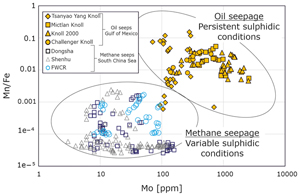 | Pyrite-based trace element fingerprints for methane and oil seepage Abstract: Pyrite forms at marine hydrocarbon seeps as the result of the microbial oxidation of methane, organic matter, and crude oil coupled to sulphate reduction. Redox sensitive and nutrient trace elements in pyrite may hold valuable information on present and past seepage events, the evolution of fluid composition, as well as the presence of heavy hydrocarbon compounds from crude oil. This study uses the trace element compositions of pyrite that formed at methane seeps and crude oil-dominated seeps to constrain element mobilities during the sulphate reduction processes, and examine the degree to which specific trace elements are captured by pyrite. Pyrite forming at oil seeps shows high Mn/Fe ratios and high Mo content compared to pyrite from methane seeps. These patterns suggest either more intense or persistent sulphidic conditions, or an intensified manganese (oxy)hydroxide shuttle process at oil seeps. Copper and Zn are enriched in oil seepage-derived pyrite while Ni and V enrichment is less pronounced, suggesting either a selective uptake of specific elements by pyrite, or varying trace element compositions of organic compounds oxidised via microbial reduction. |
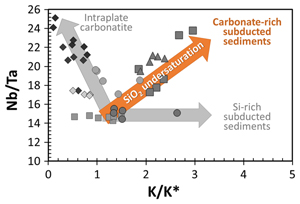 | Fractionation of Nb/Ta during subduction of carbonate-rich sediments Abstract: We report high precision high field strength element (HFSE) concentrations of Italian Plio-Quaternary mafic magmas. Silica-undersaturated rocks of the Roman magmatic province show high Nb/Ta. Instead, earlier silica-oversaturated rocks of the Tuscan magmatic province have unfractionated Nb/Ta. We show evidence that the high Nb/Ta of Roman magmas reflects subduction-derived, carbonate-rich melts. Similar melts may also account for high Nb/Ta in other silica-undersaturated magmas from the circum-Mediterranean (e.g., Macedonia, Bulgaria, Turkey) and the Sunda arc, previously interpreted to reflect residual rutile. We propose a genetic link between high Nb/Ta, silica-undersaturated magmas and recycling of carbonate-rich lithologies via subduction. As such, Nb/Ta can be used to trace the recycling of subducting carbonates. |
 | Corrigendum to “Early precipitated micropyrite in microbialites: A capsule of microbial sulfur cycling” by Marin-Carbonne et al., 2022 |
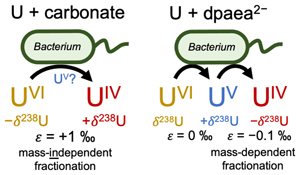 | The isotopic signature of UV during bacterial reduction Abstract: The two step electron transfer during bacterial reduction of UVI to UIV is typically accompanied by mass-independent fractionation of the 238U and 235U isotopes, whereby the heavy isotope accumulates in the reduced product. However, the role of the UV intermediate in the fractionation mechanism is unresolved due to the challenges associated with its chemical stability. Here, we employed the UV stabilising ligand, dpaea2-, to trap aqueous UV during UVI reduction by Shewanella oneidensis. Whilst the first reduction step from UVI to UV displayed negligible fractionation, reduction of UV to UIV revealed mass-dependent isotope fractionation (preferential reduction of the 235U), contrary to most previous observations. This surprising behaviour highlights the control that the U-coordinating ligand exerts over the balance between reactant U supply, electron transfer rate, and UIV product sequestration, suggesting that UV speciation should be considered when using U isotope ratios to reconstruct environmental redox conditions. |
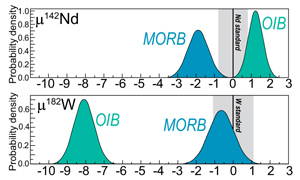 | Comparative 142Nd and 182W study of MORBs and the 4.5 Gyr evolution of the upper mantle Abstract: New high precision Nd and W isotopic compositions were obtained on the same basalt samples from the Pacific-Antarctic Ridge. These provide the best estimate so far for the μ142Nd and μ182W values of the depleted mantle source of mid-ocean ridge basalts known as DMM. The PAR basalts yield a mean μ142Nd = −1.6 ± 5.0 (2 s.d.) and μ182W = −1.9 ± 3.5 (2 s.d.), which together with the literature data allow the isotope composition of the DMM to be constrained. The present-day DMM μ182W is 10–20 ppm lower than that of the Archean mantle. This decrease could be related to the broad incorporation of mantle plume material into the upper mantle, starting between 2.4 and 3 billion years ago, due to the onset of deep cold slab subduction, and its attendant return mantle flow. |
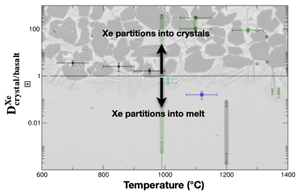 | Xenon compatibility in magmatic processes: Hadean to current contexts Abstract: Xenon (Xe) behaviour in petrological processes, albeit essential to constrain mantle ingassing and degassing models, is elusive due to its volatile nature, and lack of direct investigation at the pressures (P) and temperatures (T) relevant to magma formation and crystallisation at depth. Xenon stands out amongst noble gases due to its unique reactivity with silicates of the lower crust and upper mantle, which could at least partially explain that published mineral/melt partitioning coefficients span up to six orders of magnitude. We report partition coefficients of Xe using in situ X-ray fluorescence at high P and T, and mass spectrometry analyses. Xenon is found to be moderately incompatible in anorthite-clinopyroxene mix in equilibrium with basalt (partition coefficient value of 0.16 ± 0.06), and compatible in olivine in equilibrium with basalt (partition coefficients in the range 88 ± 22 to 302 ± 46). While Xe is, thus, concentrated in basaltic melts coexisting with crystallising pyroxenes and feldspars, it is strongly retained in olivine at depth. Consequently, Xe originally contained in solid Earth has been preferentially retained at depth throughout Earth’s history, from the magma ocean stages to present day partial mantle melting processes. |
<< Previous issueNext issue >>





